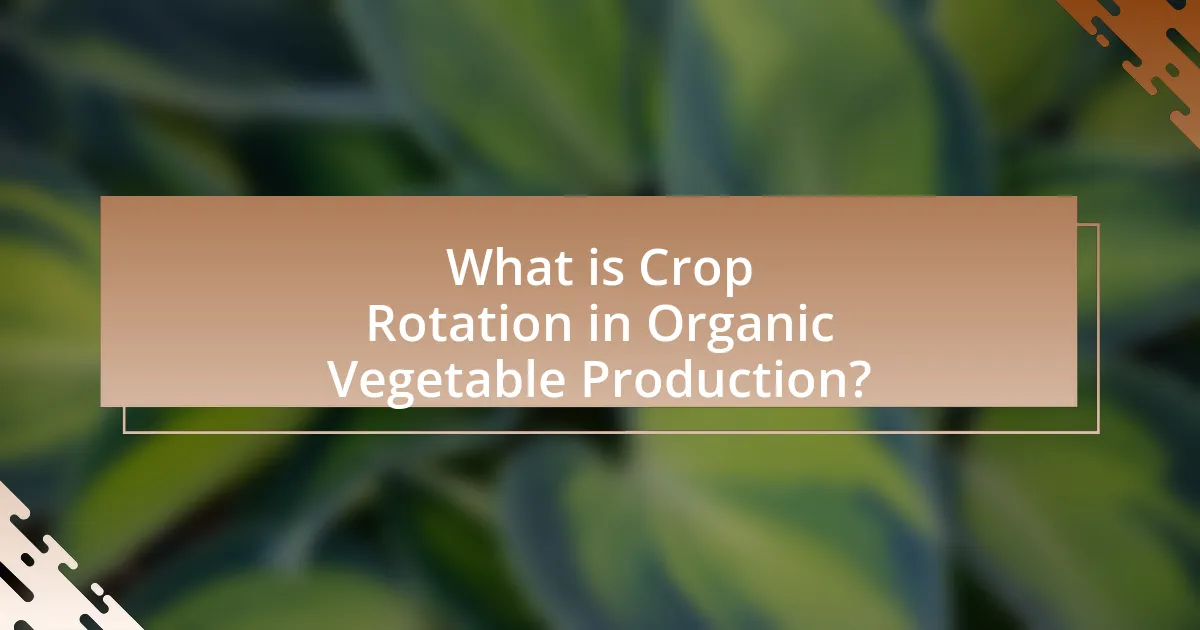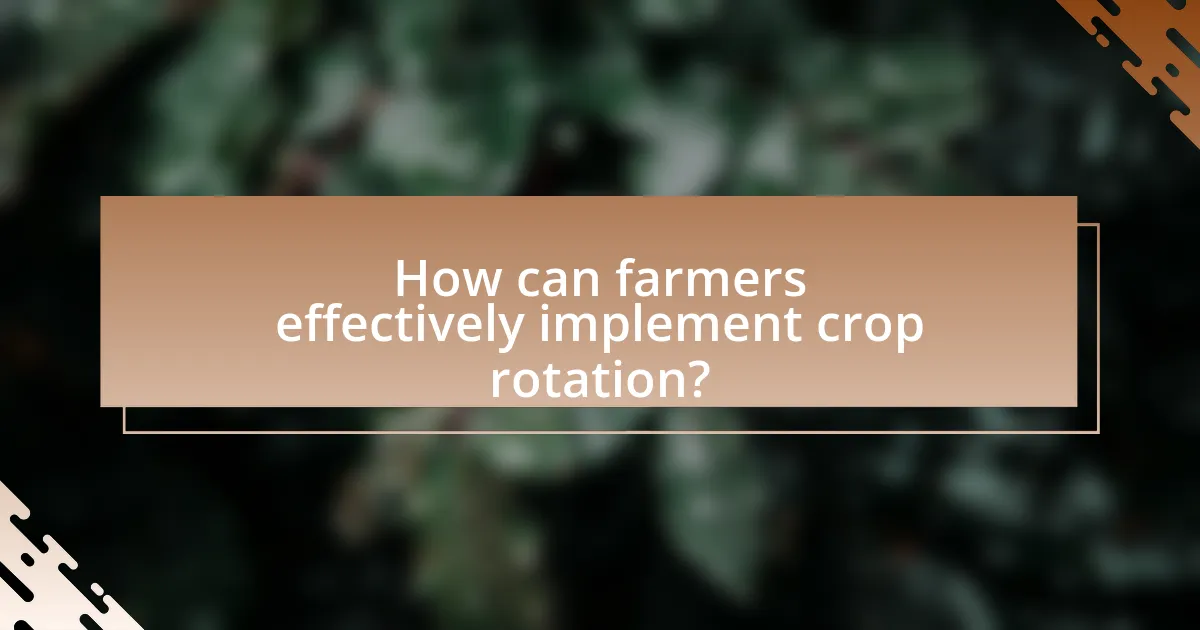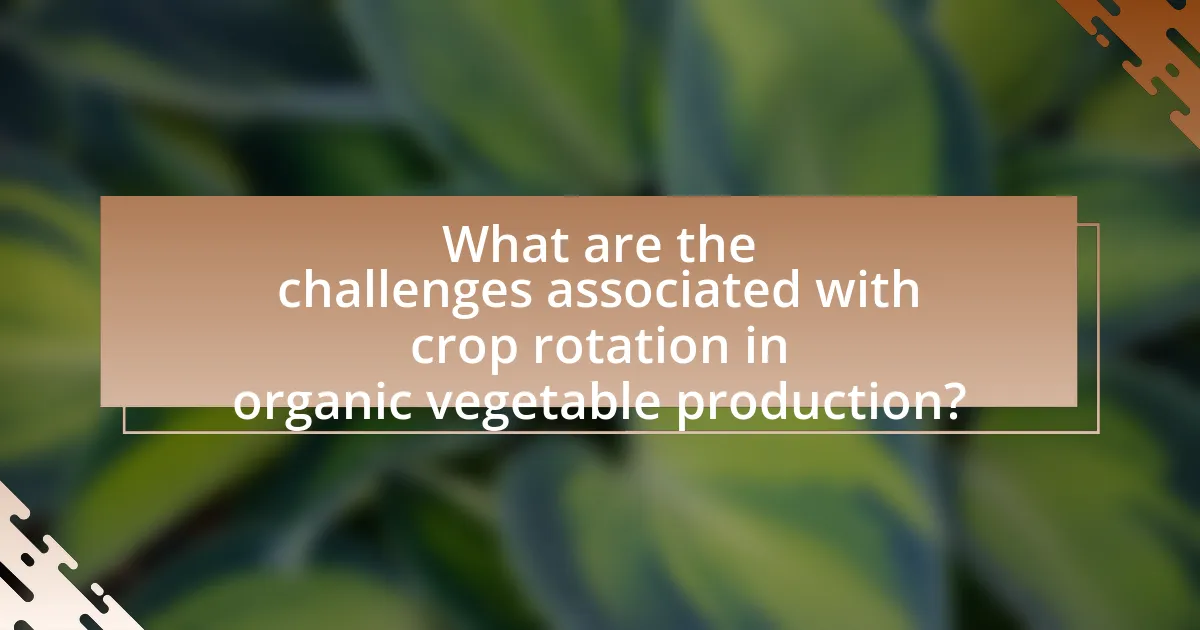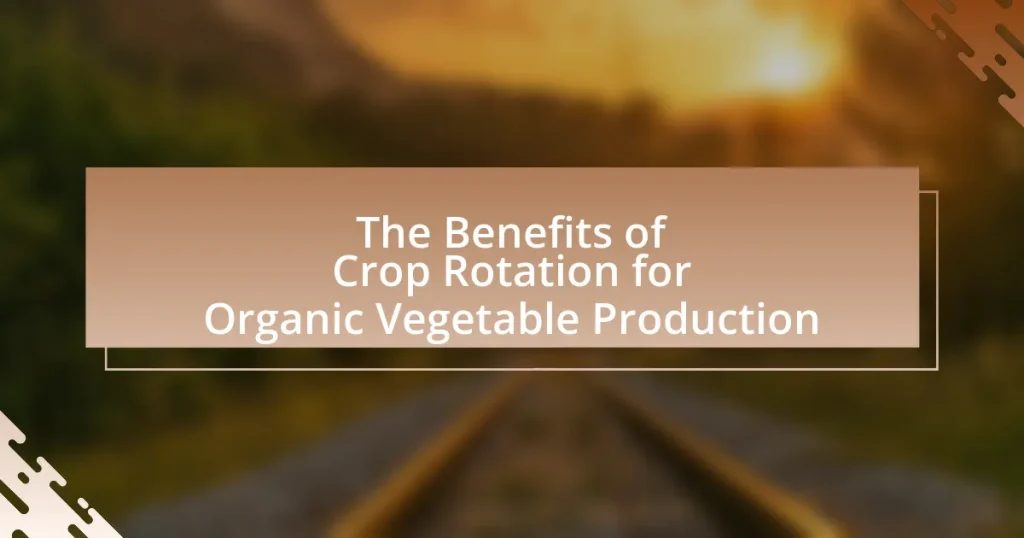Crop rotation is a crucial agricultural practice in organic vegetable production that involves systematically alternating different types of crops in a specific area over time. This method enhances soil health, improves nutrient availability, and reduces pest and disease pressure, leading to increased crop yields by 10-20% compared to continuous cropping systems. The article explores the benefits of crop rotation, including its impact on soil structure, fertility, and pest management, as well as the economic advantages for organic vegetable producers. Additionally, it addresses the challenges associated with implementing crop rotation and provides best practices for effective management, emphasizing the importance of adapting strategies to local climate conditions and market demands.

What is Crop Rotation in Organic Vegetable Production?
Crop rotation in organic vegetable production is the practice of systematically alternating the types of crops grown in a specific area over time. This method enhances soil health, reduces pest and disease pressure, and improves crop yields by preventing nutrient depletion. Research indicates that crop rotation can lead to a 10-20% increase in yield compared to continuous cropping systems, as it promotes biodiversity and soil structure. Additionally, rotating crops can disrupt the life cycles of pests and diseases, reducing the need for chemical interventions, which aligns with organic farming principles.
How does crop rotation benefit soil health?
Crop rotation benefits soil health by enhancing nutrient availability and reducing soil erosion. By alternating different crops, farmers can improve soil structure and fertility, as diverse root systems contribute to better aeration and water retention. For instance, legumes, when included in the rotation, fix nitrogen in the soil, which can significantly reduce the need for synthetic fertilizers. Research indicates that fields with diverse crop rotations show a 20-30% increase in soil organic matter compared to monoculture systems, leading to improved microbial activity and overall soil health.
What specific soil nutrients are enhanced through crop rotation?
Crop rotation enhances specific soil nutrients such as nitrogen, phosphorus, and potassium. Leguminous crops, when included in the rotation, fix atmospheric nitrogen into the soil, improving nitrogen levels significantly. Additionally, different crops have varying nutrient uptake patterns, which helps maintain a balanced nutrient profile in the soil. Research indicates that rotating crops can lead to a 20-30% increase in soil nitrogen levels compared to continuous cropping systems, thereby enhancing overall soil fertility and health.
How does crop rotation affect soil structure and fertility?
Crop rotation significantly enhances soil structure and fertility by promoting diverse root systems and organic matter accumulation. Different crops contribute varying root architectures, which improve soil aeration and water infiltration, reducing compaction. Additionally, rotating crops, especially legumes, increases nitrogen availability in the soil, as legumes fix atmospheric nitrogen, enriching the nutrient profile. Research indicates that fields with diverse crop rotations can yield up to 20% more than monoculture systems due to improved soil health and fertility. This practice also reduces soil erosion and enhances microbial diversity, further supporting soil vitality.
Why is crop rotation important for pest and disease management?
Crop rotation is important for pest and disease management because it disrupts the life cycles of pests and pathogens. By alternating crops, farmers can reduce the prevalence of specific pests and diseases that thrive on particular plants. For instance, rotating crops can prevent the buildup of soil-borne pathogens, as many pests and diseases are crop-specific. Research has shown that implementing crop rotation can lead to a significant decrease in pest populations and disease incidence, enhancing overall crop health and yield.
What types of pests and diseases can be controlled through crop rotation?
Crop rotation can effectively control various pests and diseases, including root-knot nematodes, corn rootworms, and certain fungal pathogens like Fusarium and Phytophthora. By alternating crops, the life cycles of these pests and pathogens are disrupted, reducing their populations and the likelihood of outbreaks. Research indicates that rotating crops such as legumes with non-legumes can significantly lower the incidence of soil-borne diseases and pests, as different crops attract different pests and have varying nutrient requirements, which helps maintain soil health and biodiversity.
How does crop rotation disrupt pest life cycles?
Crop rotation disrupts pest life cycles by altering the availability of host plants for pests, thereby reducing their populations. When different crops are planted in succession, pests that are specialized to feed on a particular crop find their food source diminished, leading to a decline in their numbers. For example, rotating a legume crop with a cereal crop can break the life cycle of pests like aphids, which thrive on legumes. Research has shown that this practice can lead to a significant reduction in pest populations, as evidenced by studies indicating that crop rotation can decrease pest infestations by up to 50% in certain agricultural systems.
What economic advantages does crop rotation provide to organic vegetable producers?
Crop rotation provides significant economic advantages to organic vegetable producers by enhancing soil fertility, reducing pest and disease pressure, and improving crop yields. By alternating different crops, producers can maintain nutrient levels in the soil, which leads to lower fertilizer costs and increased productivity. Research indicates that crop rotation can increase yields by 10-20% compared to monoculture systems, as diverse root structures and crop residues contribute to healthier soil ecosystems. Additionally, rotating crops can disrupt pest life cycles, reducing the need for costly organic pest control measures, thereby lowering overall production costs.
How can crop rotation reduce input costs for farmers?
Crop rotation can reduce input costs for farmers by improving soil health and reducing the need for chemical fertilizers and pesticides. By alternating crops, farmers can enhance soil fertility through natural processes, such as nitrogen fixation from legumes, which decreases reliance on synthetic fertilizers. Additionally, diverse cropping systems can disrupt pest and disease cycles, leading to lower pesticide use. Research indicates that farms practicing crop rotation can see a reduction in input costs by up to 20% due to these benefits, as demonstrated in studies conducted by the Rodale Institute, which found that crop rotation significantly enhances soil organic matter and nutrient availability.
What impact does crop rotation have on crop yields?
Crop rotation significantly enhances crop yields by improving soil health and reducing pest and disease pressure. This agricultural practice allows for the replenishment of nutrients in the soil, as different crops have varying nutrient requirements and contributions. For example, legumes can fix nitrogen in the soil, benefiting subsequent crops. Research indicates that farms employing crop rotation can experience yield increases of 10% to 25% compared to monoculture systems, as demonstrated in studies published in the Journal of Sustainable Agriculture. These findings underscore the effectiveness of crop rotation in optimizing agricultural productivity.

How can farmers effectively implement crop rotation?
Farmers can effectively implement crop rotation by planning a systematic sequence of different crops over several growing seasons to enhance soil health and reduce pest and disease pressure. This practice involves selecting crops that have varying nutrient requirements and growth habits, such as alternating deep-rooted and shallow-rooted plants, which helps in optimizing nutrient uptake and improving soil structure. Research indicates that crop rotation can lead to a 10-20% increase in crop yields and a significant reduction in the need for chemical fertilizers and pesticides, as diverse cropping systems disrupt pest life cycles and enhance beneficial soil microorganisms.
What are the key principles of designing a crop rotation plan?
The key principles of designing a crop rotation plan include selecting diverse crops, considering nutrient requirements, managing pests and diseases, and timing planting and harvesting. Diverse crops help improve soil health and reduce pest populations by breaking pest and disease cycles. For example, rotating legumes with cereals enhances nitrogen availability in the soil, benefiting subsequent crops. Additionally, planning the timing of planting and harvesting ensures optimal growth conditions and maximizes yield. These principles are supported by agricultural studies, such as those published by the USDA, which demonstrate that effective crop rotation can lead to increased soil fertility and reduced reliance on chemical inputs.
How do crop families influence rotation planning?
Crop families significantly influence rotation planning by determining the compatibility and nutrient requirements of successive crops. Different crop families, such as legumes, brassicas, and solanaceous plants, have unique interactions with soil nutrients and pests, which can enhance soil health and reduce disease pressure when rotated appropriately. For instance, legumes fix nitrogen in the soil, benefiting subsequent crops that require nitrogen, while rotating brassicas can help manage pests like aphids and cabbage worms. Research indicates that effective rotation planning based on crop families can lead to improved yields and reduced reliance on chemical inputs, thereby supporting sustainable organic vegetable production.
What factors should be considered when selecting crops for rotation?
When selecting crops for rotation, factors such as soil health, pest and disease management, nutrient requirements, and crop compatibility must be considered. Soil health is crucial because different crops can enhance soil structure and fertility; for instance, legumes fix nitrogen, benefiting subsequent crops. Pest and disease management is essential as rotating crops can disrupt pest life cycles and reduce disease incidence, which is supported by studies showing lower pest populations in rotated fields. Nutrient requirements vary among crops, and selecting a rotation that balances nutrient uptake can prevent soil depletion. Lastly, crop compatibility ensures that the selected crops do not compete for the same resources, optimizing growth and yield.
What common mistakes should be avoided in crop rotation?
Common mistakes to avoid in crop rotation include failing to diversify crops, neglecting soil health, and not considering pest and disease cycles. Diversifying crops is essential because planting the same species repeatedly can lead to nutrient depletion and increased pest populations. Neglecting soil health can result in reduced fertility and structure, as different crops contribute various nutrients and organic matter to the soil. Additionally, not considering pest and disease cycles can lead to outbreaks, as certain crops may harbor pests that affect subsequent plantings. Research indicates that effective crop rotation can reduce pest pressure by up to 50%, highlighting the importance of these practices in sustainable agriculture.
How can improper rotation lead to soil depletion?
Improper crop rotation can lead to soil depletion by failing to maintain soil nutrient balance and increasing pest and disease pressure. When the same crops are planted repeatedly in the same location, specific nutrients become depleted as those crops continuously extract them from the soil. For example, corn requires high levels of nitrogen, and without rotating with legumes that can replenish nitrogen levels, the soil becomes deficient. Additionally, continuous cropping of the same species can lead to a buildup of pests and diseases that target those crops, further degrading soil health and structure. Research indicates that diverse crop rotations can enhance soil fertility and reduce the risk of depletion, highlighting the importance of proper rotation practices in sustainable agriculture.
What are the consequences of neglecting crop diversity?
Neglecting crop diversity leads to increased vulnerability to pests and diseases, resulting in reduced yields and economic losses for farmers. When farmers rely on a limited number of crop varieties, they create an environment where pests and diseases can thrive, as these organisms adapt to the specific crops being cultivated. For instance, monocultures have been linked to the rapid spread of pests like the corn rootworm, which can devastate entire fields. Additionally, reduced genetic diversity limits the resilience of crops to environmental changes, such as climate fluctuations, which can further threaten food security. Studies have shown that diverse cropping systems can enhance ecosystem services, such as soil health and pollination, which are critical for sustainable agricultural practices.

What are the challenges associated with crop rotation in organic vegetable production?
The challenges associated with crop rotation in organic vegetable production include pest management, nutrient availability, and market demand. Pest management can become complex as certain crops may attract specific pests, complicating the rotation strategy. Nutrient availability is another challenge, as different crops have varying nutrient requirements, which can lead to soil depletion if not managed properly. Additionally, market demand for specific crops can limit the effectiveness of rotation, as farmers may be pressured to grow what is most profitable rather than what is best for soil health. These challenges highlight the need for careful planning and management in organic vegetable production to ensure sustainable practices.
How do climate and weather conditions affect crop rotation practices?
Climate and weather conditions significantly influence crop rotation practices by determining the types of crops that can be successfully grown in a given area. For instance, regions with a warm climate may favor the rotation of heat-loving crops like tomatoes and peppers, while cooler climates may necessitate the inclusion of cold-tolerant crops such as kale and carrots. Additionally, precipitation patterns affect soil moisture levels, which can dictate planting schedules and crop selection; for example, areas with high rainfall may require crops that are more resistant to waterlogging. Research indicates that effective crop rotation can enhance soil health and reduce pest and disease pressures, making it essential to adapt these practices based on local climate and weather conditions.
What strategies can be employed to adapt crop rotation to changing climates?
To adapt crop rotation to changing climates, farmers can implement strategies such as diversifying crop types, adjusting planting schedules, and incorporating cover crops. Diversifying crop types enhances resilience by spreading risk across various species that may respond differently to climate variations. Adjusting planting schedules allows farmers to align crop growth stages with optimal climate conditions, thereby maximizing yield potential. Incorporating cover crops improves soil health and moisture retention, which is crucial in fluctuating weather patterns. Research indicates that these strategies can lead to improved soil fertility and reduced pest pressures, ultimately supporting sustainable organic vegetable production.
How can farmers mitigate risks associated with crop failure in rotation systems?
Farmers can mitigate risks associated with crop failure in rotation systems by diversifying their crop selection and implementing cover cropping. Diversifying crops reduces the likelihood of total failure due to pests or diseases that may target specific plants; for instance, rotating legumes with cereals can improve soil health and reduce pest populations. Implementing cover crops, such as clover or rye, enhances soil structure and fertility, which can lead to better yields and resilience against adverse weather conditions. Research indicates that farms utilizing diverse rotation systems experience up to 20% higher yields compared to monoculture systems, demonstrating the effectiveness of these strategies in risk mitigation.
What resources are available to support farmers in crop rotation?
Farmers can access various resources to support crop rotation, including agricultural extension services, online databases, and educational workshops. Agricultural extension services provide expert advice and tailored recommendations for crop rotation practices, helping farmers optimize their yields and soil health. Online databases, such as the USDA’s National Agricultural Library, offer research articles and guidelines on effective crop rotation strategies. Additionally, educational workshops conducted by universities and agricultural organizations teach farmers about the benefits and implementation of crop rotation, enhancing their knowledge and skills in sustainable farming practices.
How can agricultural extension services assist with crop rotation planning?
Agricultural extension services can assist with crop rotation planning by providing farmers with research-based information and tailored recommendations on crop selection and timing. These services analyze local soil conditions, pest pressures, and climatic factors to develop effective rotation strategies that enhance soil health and optimize yields. For instance, studies have shown that well-planned crop rotations can reduce pest populations and improve nutrient availability, leading to increased productivity in organic vegetable production.
What role do online tools and software play in crop rotation management?
Online tools and software play a crucial role in crop rotation management by enabling farmers to plan, monitor, and analyze their crop rotations effectively. These digital solutions provide features such as data tracking, yield forecasting, and pest management recommendations, which enhance decision-making processes. For instance, software like CropTracker allows farmers to visualize crop performance over time, facilitating informed choices about which crops to plant next based on historical data and soil health metrics. Additionally, research indicates that utilizing such tools can lead to improved crop yields and reduced input costs, demonstrating their effectiveness in optimizing agricultural practices.
What are some best practices for successful crop rotation?
Successful crop rotation involves alternating different crops in a specific sequence to enhance soil health and reduce pest and disease pressure. Best practices include selecting crops from different plant families to disrupt pest cycles, incorporating cover crops to improve soil structure and fertility, and timing planting and harvesting to optimize nutrient use. Research indicates that rotating crops can lead to a 10-20% increase in yield compared to monoculture systems, as diverse root structures improve soil aeration and nutrient uptake. Additionally, rotating legumes with other crops can fix nitrogen in the soil, further enhancing fertility and reducing the need for synthetic fertilizers.
How can farmers monitor and evaluate the effectiveness of their crop rotation?
Farmers can monitor and evaluate the effectiveness of their crop rotation by tracking soil health indicators, crop yields, and pest and disease prevalence. Soil health can be assessed through regular soil testing, which measures nutrient levels, pH, and microbial activity, providing insights into the impact of different crops on soil fertility. Crop yields can be compared across different rotation cycles to determine which combinations produce the highest outputs, while monitoring pest and disease occurrences helps identify any changes in pest pressure related to specific crop sequences. Research has shown that diverse crop rotations can reduce pest populations and improve soil structure, leading to better overall farm productivity.
What tips can enhance the benefits of crop rotation in organic vegetable production?
Implementing diverse crop rotations enhances the benefits of crop rotation in organic vegetable production. By rotating different plant families, farmers can improve soil health, reduce pest and disease pressure, and optimize nutrient cycling. For instance, incorporating legumes in the rotation can fix nitrogen in the soil, benefiting subsequent crops. Additionally, timing the planting and harvesting of crops to maximize soil cover and minimize bare ground can prevent erosion and weed growth. Research indicates that farms practicing diverse crop rotations can yield up to 20% more than those with monoculture systems, demonstrating the effectiveness of these strategies in organic vegetable production.










